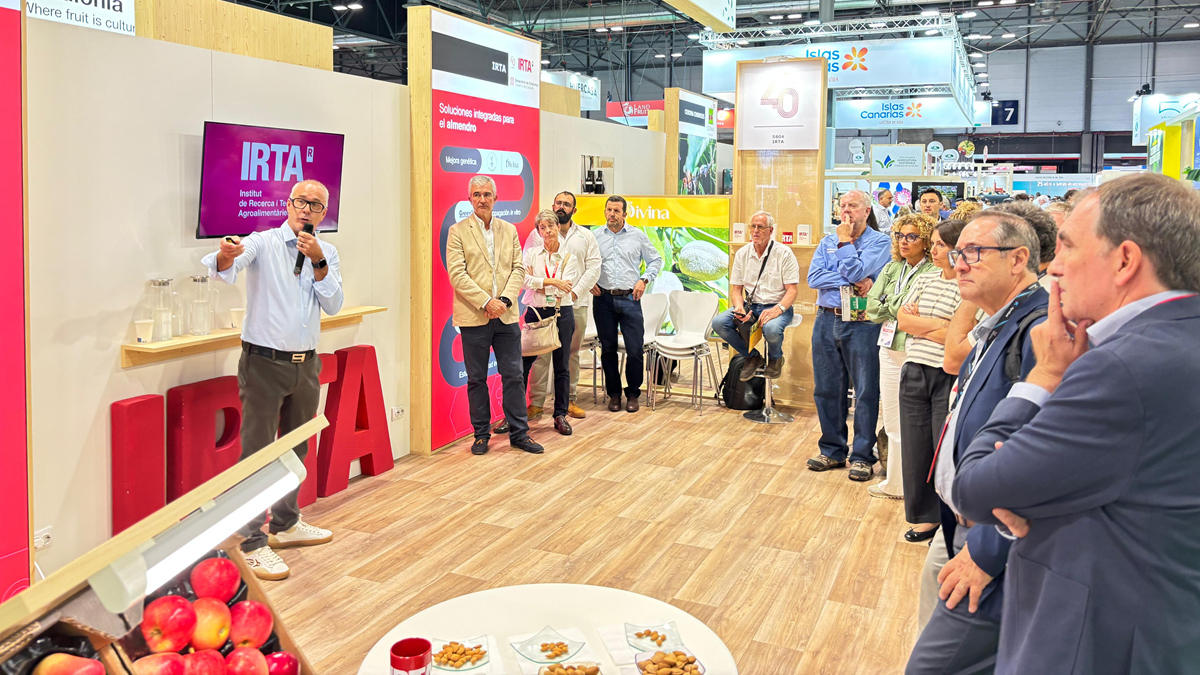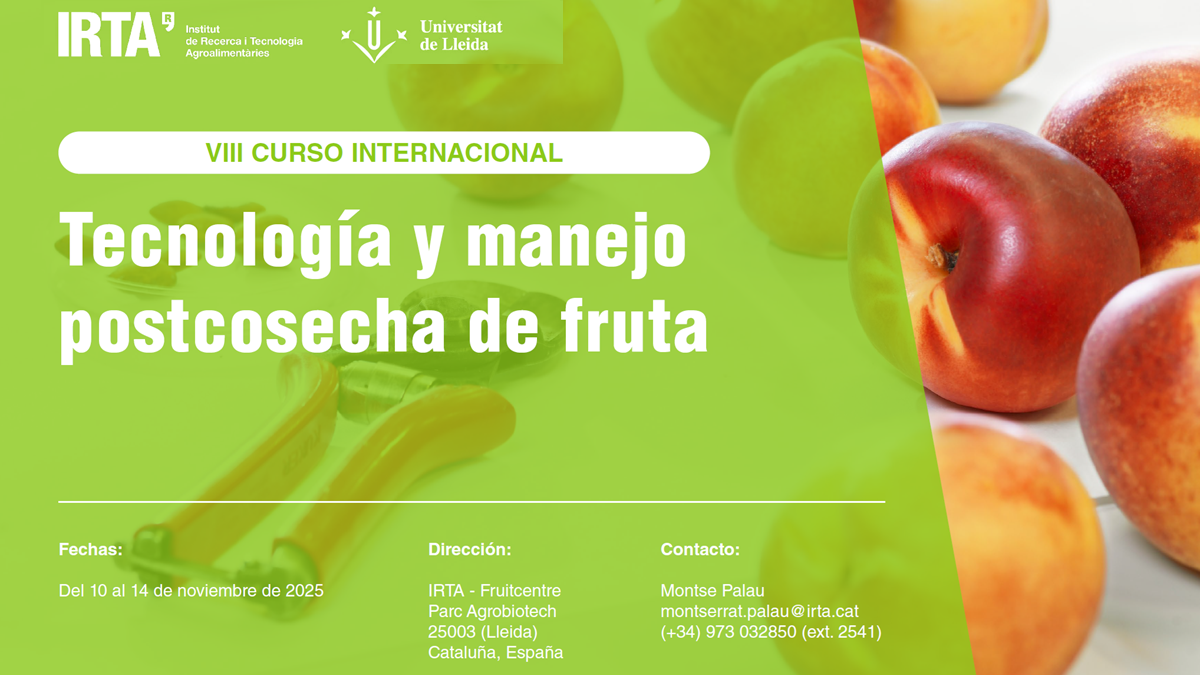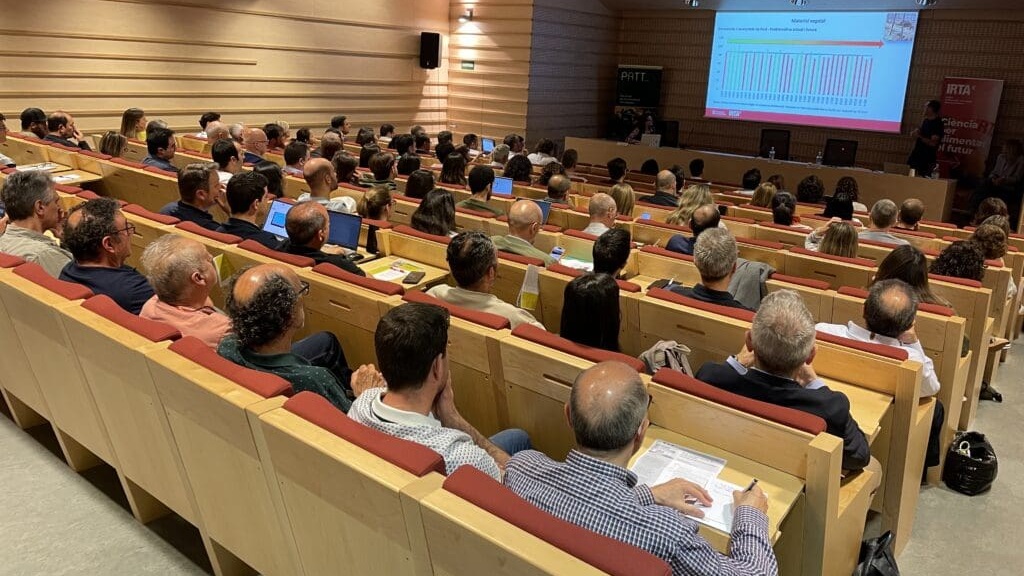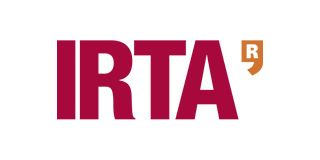

IRTA
Services
Update on Advances in Fruit Preservation at IRTA
Fruit hygiene, prediction of postharvest potential and its improvement, and diseases were among the topics at the XXII IRTA Lleida Postharvest Conference
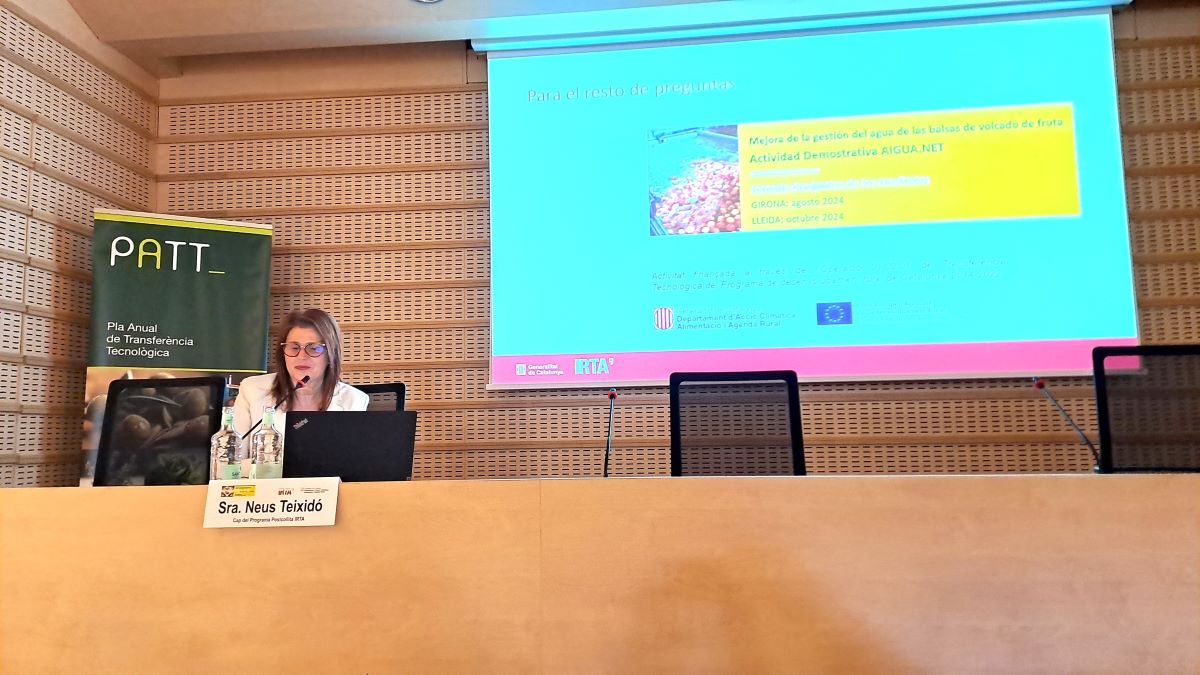
Researchers from IRTA and companies specializing in postharvest participated in the "XXII Technical Postharvest Conference," which took place on May 30th. This event serves as an opportunity to review the previous season and present the results of trials and technical innovations.
Neus Teixidó, head of the IRTA Postharvest Program, chaired the meeting and, at the end of the morning lectures, introduced the VII International Course on Fruit Postharvest Technology and Management, to be held from November 11 to 15, 2024, at the Fruitcentre in Lleida.
The event was sponsored by Absoger, AgroFresh, Maf Roda, Citrosol, Felix Instruments, Fruit Control Equipments, Ilerdagua, Ilerdfred, Isolcell, Nabaco, Pampols, tmc (Talleres y Montajes Ceba), Decco, Timfred, Unitec, Basf, and Santander Agro.
Rinsing, an Essential Operation in Fruit and Vegetable Processing Centers
The AIGUA.NET project aimed to understand what happens in the water tanks of fruit and vegetable processing centers to manage water more sustainably in relation to contamination levels and the residues that can accumulate. Pilar Plaza from IRTA presented studies conducted in centers equipped with different water treatment systems. This has allowed answering a series of questions:
- What levels of fungal contamination are there in the dumping tank water? It depends on the management. Without continuous filtration and with low doses of disinfectant, easily 100 CFU/ml, even 1000 CFU/ml.
- What level of fungal contamination is needed to rot the fruit? It depends on the variety, maturity stage, wounds, and pathogen: 10 CFU/ml can cause 10% rot, 100 CFU/ml can cause 40% rot, and 1000 CFU/ml can cause 60% rot.
- What level of chemical contamination is there in the dumping tank water? Many chemical residues can accumulate in the water, but at very low concentrations (less than 1 ppm), except for chlorates.
- What level of chemical contamination is needed to contaminate the fruit? Depending on the level of accumulated chlorates and the variety, they can leave residues on the fruit.
- What role do rinsing showers play? They are essential to reduce chlorate residues and the risk of rotting.
Having an active carbon filter has been shown to eliminate chlorates that accumulate during 9 weeks of water use.
This topic is covered in one of the chapters of the book (In Spanish) “Water Sustainability in Horticulture and Postharvest,” “Water Saving in Fruit and Vegetable Processing Centers,” authored by Pilar Plaza, Natàlia Alòs, Sara Acosta, Maribel Abadias, Elena Costa, and Neus Teixidó.
A Camera to Understand Everything About Fruit and Aid Decision-Making
The "Postharvest Potential Prediction Platform and Sensorized Chamber" is part of IRTA's Digital AgroLabs, spaces for agricultural testing and experimentation specialized in digitization for each research center's area of study. Elena Costa from IRTA explained the setup at IRTA in Lleida for conducting fruit preservation work, which could also be visited in the afternoon. Its objective is to serve as a Decision Support System (DSS) for the preservation of stone fruit.
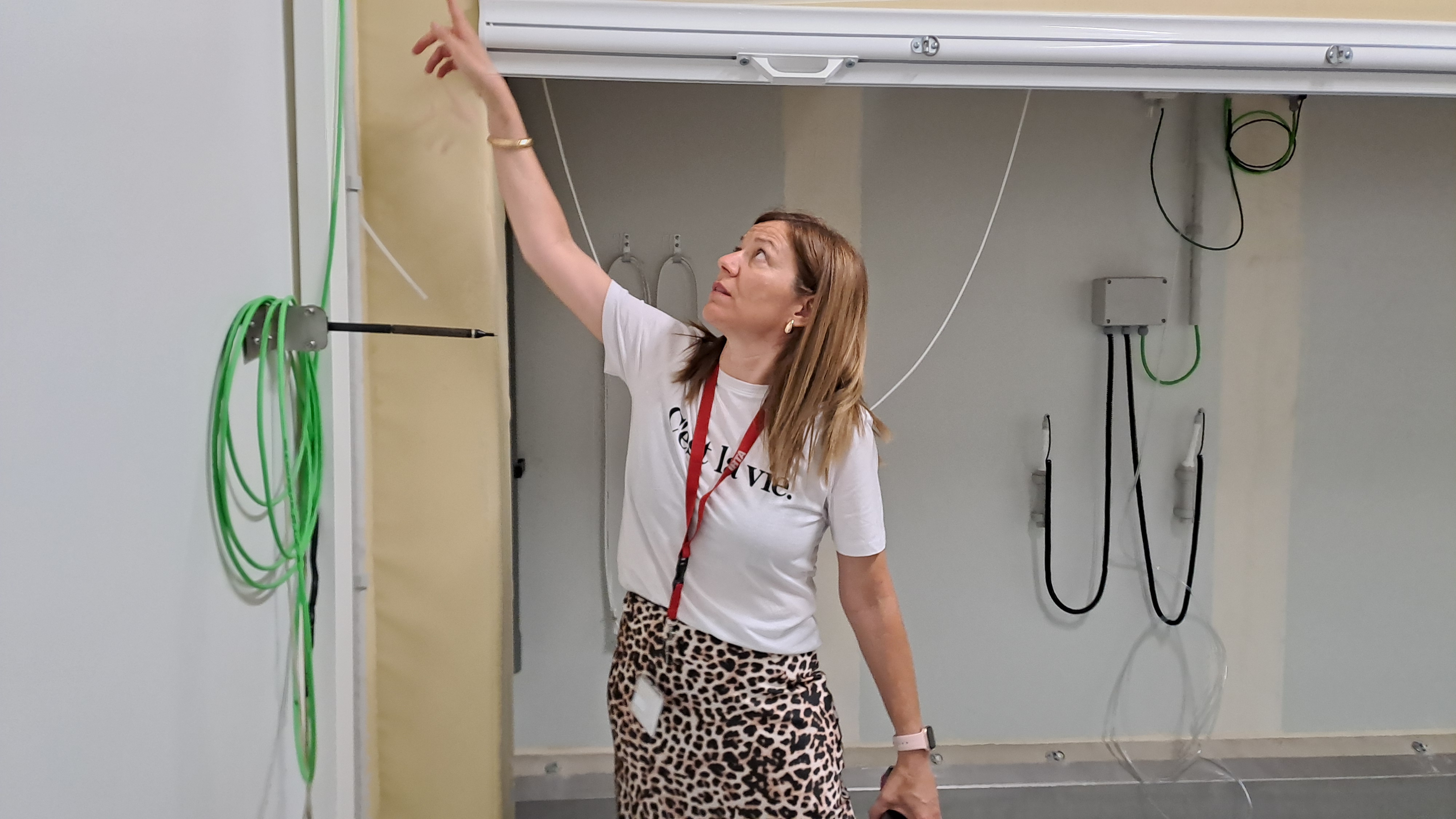
Elena Costa displays one of the multiple sensors equipped in the chamber.
The chamber is equipped with all necessary devices to establish a Modified Atmosphere, with a control system developed by Ilerfred. It contains various sensors and analyzers to evaluate what happens inside it and to the fruits (fruit and ambient temperature, hygrometers, anemometers, thermographic cameras, pressure meters, and analyzers for ethylene, oxygen, and carbon dioxide).
It also features a hyperspectral device to measure color, maturity, physiopathies, rot, etc.; the Max Fresh system from Storex to evaluate volatiles; and scales to measure the fruit's water loss, which causes dehydration.
These data feed a preservation decision-making platform based on neural networks, which, once properly trained, will allow the definition of the chamber's output parameters (preservation time, damage upon exit, weight loss, etc.).
The Fruits of Dedicating 3% Annually to R&D
MAF RODA is a French multinational engineering company with over 100 years of experience in manufacturing solutions for sorting, grading, and packaging fruits and vegetables, and their automation. Present in 79 countries, one of its main characteristics is 100% in-house manufacturing, and its most ambitious solutions use AI and Big Data to offer highly precise internal and external quality analysis, including defects, color, shape, diameter, weight, Brix levels, and rot.
Josep Molina from MAF RODA presented the latest innovations from this company, which invests 3% of its annual revenue in R&D and offers turnkey solutions. Among these innovations are Globalscan 7, for the detection of external defects, and Insight, for analyzing Brix levels. Globalscan 7 uses a multispectral system with AI algorithms; the fruit, including cherries, rotates 360 degrees, and high-definition images provide highly accurate results.
The framework for all Globalscan 7 equipment is common, allowing improvements to benefit other fruits as well. It is also a versatile system, ideal for warehouses processing different types of fruit.
IDD is the system for detecting internal defects. It does not require a calibration model, the startup protocol is simple, and the software is user-friendly.
Insight, the Brix level detection system, analyzes the fruit using 600 wavelengths.
MAF RODA has new software for cherries and blueberries and also new software for citrus. They share ease of use and a low learning curve.
Additionally, among the new developments are a new grader for R&D, robotic solutions for fruit handling and logistics, and water treatment solutions.
In the latter area, a MAF RODA Arrowlake alliance enables open tanks to be equipped with ozone-based disinfection, a gas that leaves no residues.
Access the MAF RODA solutions catalog.
Optimization of Chamber Opening
When should a Controlled Atmosphere (CA) chamber be opened to market the fruit? Answering this crucial question is the goal of the "Strella" technology, presented by Raquel Ledesma from Agrofresh. The company has been commercializing this technology for five years, and starting in 2024, it is also available in Europe.
Deciding the order in which to open the chambers involves understanding the ripeness of the fruit stored in CA. The factors determining the fruit's condition are varied and include ripeness at harvest, type of installation, temperature, humidity, and the essential role of gases, particularly ethylene, which is closely linked to the ripeness of climacteric fruits.
Strella is a wireless device placed inside the chamber that measures ethylene in real-time to predict ripeness and establish an opening order for the chambers. It features wireless sensors that continuously measure ethylene, carbon dioxide, oxygen, temperature, and humidity in the CA chamber.
Measurements are taken using a patented biosensor that detects ethylene (each device contains 8 biosensors). The electrode substrate is coated with a biological receptor, "biosensor," and a stabilizing conductive layer. When ethylene contacts the receptor, a change in electrochemical properties occurs, allowing detection of concentrations between 0 and 100 ppm.
Measurements are taken every 10 minutes, are wireless, and data is transmitted via radiofrequency.
The data provided by Strella also allows for alerts on conservation issues, unintentional introduction of gases or air into a chamber, etc.
Continuous ethylene measurement data are analyzed using an algorithm that optimizes the order of chamber openings, thereby optimizing the quality of the offered fruit. Additionally, user-designed alerts can be activated.
Besides Strella, AgroFresh has a broad portfolio of postharvest solutions used worldwide to preserve the quality and extend the shelf life of fresh produce, reducing food loss and waste. The technology to slow ripening with 1-methylcyclopropene (1-MCP) was pioneered through SmartFresh™. Recently, Uvasys™, SO2-generating sheets that minimize fungal rot in fruits and flowers, was added.
These are complemented by postharvest protection products (waxes, coatings, detergents, and disinfectants), application and dosing equipment, and control systems in degreening and storage chambers.
Unraveling the Secrets of Sour Rot
Sour rot, caused by Geotrichum in stone fruit, has transitioned from an emerging disease to an established one; in fact, there is an Operational Group dedicated to studying it. Carla Casals from IRTA explained the results of a survey conducted with 169 identified advisors and what is currently known about the behavior of this fungus. It is a pathogen associated with climate change, favored by high temperatures; it grows well at 30ºC, compared to the 20ºC preferred by Monilinia.
Its presence has been detected since 2016, and at the 2021 Postharvest Conference, the disease was discussed as emerging. Monilinia remains the primary pathogen of stone fruit, followed by Rhizopus, but Geotrichum now ranks third. Sour rot can appear due to the presence of this fungus, G. candidum, or by the yeasts Pichia kluyveri and P. kudriavzevii alone or associated with the fungus.
The fungus affects both in the field and postharvest, but symptoms can differ. In postharvest, it is characterized by peeling of the fruit, with the skin separating at the slightest friction.
In sour rot, which is considered the causal agent, other associated microorganisms have also been observed.
It is a watery rot with a characteristic acidic odor, with the appearance of white mycelium on the fruit.
Field treatments used to control Monilinia and Rhizopus are not effective against Geotrichum. Cultural measures are the main tool available, along with good postharvest practices, ensuring the hygiene of water and surfaces.
Inoculum in the field is found in the pits of fallen fruit and the soil, but it is not present in grass. Inoculum decreases with soil depth. Conidia are dispersed by the wind, so techniques that prevent them from reaching air currents, such as vegetation, are helpful. In postharvest, the disease is not commonly found upon entering storage nor is the presence of conidia in the air frequent. However, poor water management practices can aid its spread, as can inoculum presence on packing lines with poor hygiene.
Disinfectants such as sodium hypochlorite, peracetic acid, and chlorine dioxide have all been found effective.
The incidence of the disease in postharvest is influenced by transit time and the type of packaging used. Trays protected with flow packs show more incidence than those without plastic, likely due to the higher relative humidity inside the flow pack.
Sensitivity varies among varieties, and part of the work involves evaluating the behavior of new materials.
The publication (In Spanish) “Diseases in Stone Fruit - Key Points to Consider for the Control of Geotrichum spp., a Reemerging Disease Affecting Postharvest” by the speaker and other IRTA researchers delves deeper into this disease.
Valorization of Fruits and Vegetables with Cosmetic Defects
Utilizing fruits and vegetables with deformities or other defects that do not affect their taste quality is a potential way to economically benefit from these products. Ingrid Agulló from IRTA discussed this topic.
The term "Dominai" encapsulates the aspects to master for leveraging fruits and vegetables with cosmetic defects: Distribution, Elaboration, Modeling, Intermediate Food Products (PAI), Ingredients, Opportunity, and Innovation.
For several years, initiatives have aimed to reduce food waste through various options, such as selling irregularly shaped products like Intermarché's "Too Good to Go" initiative or using them in juices, jams, canned fruits, snacks, soups, sauces, beverages, or IV and V range products.
In addition to these more traditional forms of utilization, other options like modeling are emerging. This involves adapting a product to the final desired product. It requires culinary creativity, adjusting the raw material to the product, specific equipment, ensuring quality (nutritional, organoleptic, food safety), and validating it with consumers. Agulló mentioned examples using 75% brassica waste in their production.
Other examples include making fish analogs using eggplants or zucchinis with vacuum impregnation.
A study revealed that only 10% of consumers are familiar with products made from rejects, but if informed, 80% would buy them.
Intermediate Food Products (PAI) are another utilization option. These include purees, concentrates, pulps, frozen fruit pieces, and dehydrated powder products used in the dairy and bakery industries. These products require specific characteristics in color, acidity, rheology, and viscosity to be incorporated into final products.
These ingredients have a technological function where understanding the desired product is crucial to using the appropriate extraction technology.
Examples of PAI include apple or pear remnants transformed into powder for use in various fish analogs. Other PAI can be essential oils, fibers, colorants, sweeteners, pectins, proteins, polyphenols, or specific vegetables.
A more conventional way to integrate PAI is in pasta, snacks, etc.
Another PAI option is extracting specific compounds, such as glucosinolates from brassica remnants or antioxidants. Apple peel, besides being rich in fiber, has sweetening power. SAT Ort Bell produces a sugar-free spread based on it. Apple peel can be added to overripe fig jams, enhancing color and fiber content.
Companies are already promoting the presence of components based on "ugly fruits."
Alternative proteins, obtained from vegetables or microbial sources, are another ingredient option, an area IRTA is also researching. Microbial protein has high nutritional value and excellent texturizing properties.
The speaker mentioned a list of products made from peach and nectarine derivatives.
IRTA has a facility to test the development of new products, including their packaging, to conduct acceptance tests with final consumers.
Lenticelosis: Physiopathy Associated with Climate Change
Joan Bonany from IRTA, in collaboration with Jordi Cabrefiga, discussed in their presentation that with climate change, there has been not necessarily new disorders but rather an increased incidence of existing ones. Issues such as Gala discoloration, sunburn, vitrescence, low firmness, and conditions like lenticelosis, microcracking, and russeting are becoming more prevalent, which are challenging to distinguish from each other as physiopathies. Bonany highlighted a significant rise in problems related to lenticels over the past two seasons.
Since the 1980s and 1990s, there have been almost no negative anomalies in temperature, with nearly all being positive, approaching around 2.5ºC.
For a comprehensive understanding of any disorder, it's essential to accurately describe the problem to distinguish between bitter pit (related to nutritional imbalances involving Ca, Mg, and K), plara, lenticel blotch pit, and others, which manifest as spots developing from the lenticel. Jonathan Spot also initiates from the lenticel.
"Lenticelosis" or "lenticel breakdown" should encompass all lenticel-related issues. It typically manifests on the less exposed part of the fruit, especially at the boundary between colored and non-colored areas, predominantly in post-harvest stages.
Lenticel pit results in blackened lenticels. The pulp remains unaffected, appearing as early as June, with a prevalence on the eastern side. It does not progress post-harvest, and bagging the fruit prevents this physiopathy.
"Green spots" are decolorized patches that may turn green and later darken. These are observed in the USA and are also reduced when fruit is bagged.
Lenticels are natural openings in the fruit skin composed of cuticle, epidermis, and hypodermis, facilitating gas exchange. They originate from stomata, trichomes, and small epidermal fissures. Microcracking can lead to russeting.
Lenticels can be either closed or open, a distinction studied since 1935. Open lenticels are likely damaged. Since the greatest fruit growth occurs in the early stages, this is when lenticel damage occurs, although further studies are needed to understand this timing better. During the discussion, a Decco product was mentioned, used early in fruit development to prevent damage.
These structures define skin quality alongside the cuticle and epidermis; climate, genetics, and management ultimately affect skin quality.
Bonany suggests efforts to improve skin quality, enhancing overall fruit quality definition.
Variation in turgor under the lenticel leads to phenol oxidation, which becomes autocatalytic. Genetics influence lenticel density; Golden has several clones with different densities. Rain protection prevents skin cracking. Studies by the Cracking Fuji 2019 Operational Group showed a 50% reduction in cracking under rain covers compared to controls (19.7% vs. 42.1%).
The percentage of open and closed lenticels relates to breakdown; prediction methods highlight the importance of lenticels. Post-flowering gibberellins result in fewer problematic lenticels. Water scarcity leads to rapid growth during rainfall, causing issues. Fertilization management shows less lenticelosis with higher calcium and more potassium. Pre-harvest lipid formulations significantly reduce damage, attributed to a corrective effect. Post-harvest tempering of fruit also serves as a corrective measure to minimize symptoms.
In conclusion, Bonany advocates for detailed symptom descriptions to understand the phenomenon better. In 2022 and 2023, various factors aligned, resulting in higher temperatures (El Niño/La Niña, solar cycle, eruption, etc.). Global models considering all factors affecting skin quality are needed, along with measures to enhance it.
Lenticels can also be affected by fungi, leading to rot; two emerging and two common rots have increased with lenticel problems.
- Bull's eye rot, caused by Neofabraea, is growing globally, especially in late-harvested cultivars. Moist conditions in September and October favor field infection, manifesting in fruit after 3 to 4 months in storage. It causes cankers on branches and does not spread from fruit to fruit initially.
- Bitter Rot, caused by Colletotrichum spp., is increasing frequency and affects late cultivars. Symptoms appear in the field, advising tree sanitation and phytosanitary treatments.
- Anthracnose (Bitter Rot, Colletotrichum spp.) originates from field infections through lenticels and is linked to rain episodes, also requiring field sanitation and treatments.
- Alternariosis is favored by micro-cracks or broken lenticels, leading to symptoms through field infections, mainly through wounds.
- Penicillium infection occurs in storage and through wounds. Thorough disinfection of critical points (water in calibrator and chambers) is crucial.
Protecting skin and lenticel integrity involves stress avoidance to allow the cuticle to function as protection, minimizing the need for subsequent treatments and waste generation.
The table below summarizes the characteristics of the main skin disorders:
- Bitter pit - Gray, brown, or black spots; Depressed, round, or slightly angular spots; Flesh beneath the spot is brown, spongy, and corky; Starts pre-harvest but develops and manifests post-harvest; More prevalent in young trees with light crop load and large calibers; Enhancing factors: irregular watering, high nitrogen input, severe pruning or thinning; Nutritional imbalance: Ca, Mg, K.
- Plara (Lenticel blotch pit) - Irregular profile; Centered on lenticels and results in tissue sunken relative to fruit surface; Flesh beneath the spot is dark (brown); Fruit exposed part; Starts pre-harvest but evolves and manifests post-harvest.
- Jonathan Spot - Surface spots originating from lenticels; Slightly sunken spots with a halo; Flesh beneath the spot may be brown, dry, and spongy; Dry climate, large apples, and late harvest are enhancing factors.
- Lenticel breakdown - Nearly circular brown spots around a lenticel; Spots enlarge and may merge into larger irregular spots; Flesh beneath the spot is unaffected; Manifests in less exposed part and colored margin of the fruit; Typically appears post-harvest; Nutritional imbalance: Ca, Mg, K.
- Lenticel pit - Nearly circular black spots around lenticel; Flesh beneath the spot is unaffected; Manifests on the most exposed part of the fruit; More prevalent on the east-facing side of trees; Appears from July; Does not progress post-harvest; Bagging significantly reduces damage.
- Green spot - Discolored spots that can turn green and later darker; Some authors associate it with damage to lenticels; Surface flesh affected superficially; Observed pre-harvest; Debate on nutritional imbalance implication; Bagging reduces it.
NatuWrap: Coating for Post-Harvest Protection
Sergio Blasco from Nabaco presented NatuWrap, a product designed to address one of the main challenges in post-harvest fruit management: water loss. NatuWrap not only controls dehydration but also offers additional beneficial functions.
NatuWrap is a technological adjuvant based on clays with natural polymers that self-assemble. It is edible and prolongs fruit shelf life by forming a transparent, tasteless, and odorless coating. The ingredients in this coating assemble almost at the level of nanoparticles, creating a tortuous path for gases.
This tortuous path significantly reduces the ingress rate of oxygen and exogenous ethylene into the fruit, as well as water loss as vapor.
Key Features and Benefits of NatuWrap:
- Organic Barrier Technology: It serves as a barrier to gases and is based on organic products.
- Application and Cost: It is easy to apply, cost-effective, and suitable for both conventional and organic production. It is currently in the process of organic certification by CAAE and has a zero carbon footprint.
- Versatility: There are specific formulations for various fruit species such as pear, apple, plum, nectarine, and cherry.
- Performance: In pears, it has been shown to increase color and firmness retention by 50%, enhance fungicidal efficacy by 50%, reduce scalding and bruising by 50%, and improve gas barrier properties by 20%.
- Apple-Specific Formulations: For apples, NatuWrap includes a formulation called Seal TM, which prevents moisture loss and offers different shine options. It delays color loss and aging significantly after 7 weeks at ambient temperature.
- Enhanced Delivery of Fungicide: NatuWrap improves the delivery of fungicides, achieving 95% of the expected LMR (Legal Maximum Residue). NatureWram Plum Preserve is particularly effective as a carrier for fludioxonil, preserving green peduncles in cherries and improving surface pressure and shelf life in plums, nectarines, and cherries.
- Environmentally Friendly: The coating can be washed off with water, reducing fungicide residues by up to 90%. It also offers flexibility in adjusting LMR levels on demand and provides extra protection during storage to prevent resistance issues.
Overall, NatuWrap represents a significant advancement in fruit preservation technology, offering comprehensive benefits in maintaining fruit quality, extending shelf life, and ensuring food safety while minimizing environmental impact.
Development of Artificial Intelligence-based tools to facilitate prediction
Having information that allows for simple understanding of the tree's water status, its health condition, expected harvest yield, post-harvest fruit shelf life, has for years relied on tools such as sensorization and more recently, artificial vision, a subset of AI enabling computers to extract meaningful information from digital images and videos.
In some of these areas, practical solutions already exist, while others remain fields of ongoing research. Luigi Manfrini from the University of Bologna explained the work being done with computer vision (CV) and AI to detect physiological disorders, fruit quality, and ripeness within the Eco Pom project framework. He states, "AI allows computers to think; computer vision (CV) enables them to see, observe, and comprehend."
Computers process digital images and videos composed of pixels. The mission of computer vision is to interpret these pixels using complex algorithms, notably convolutional neural networks (CNNs). This enables computers to analyze pixels and patterns, allowing them to recognize shapes, objects, and even faces by comparing them with vast amounts of data.
The development of CV algorithms enables precise management of orchards, providing valuable information to fruit growers to enhance their management practices. The most obvious application is predicting production by identifying fruit loads in the orchard.
What happens in the orchard results from the interaction of genetics, environment, and cultural practices. Even with knowledge of these variables, there is no one-size-fits-all automated solution (the "black box" concept), necessitating the design, testing, and validation of specific solutions.
The goal is to develop coded algorithms that can be integrated, for example, into an autonomous vehicle (robot) capable of traversing the orchard to recognize fruit quality, ripeness, physiological disorders, and adapting this capability to a post-harvest equipment using computer vision to anticipate fruit behavior.
Professor Manfrini's specific project aims to develop a low-cost system based on a consumer-grade RGB camera capable of automatically extracting information about fruit quality post-harvest. The project utilizes evaluations of apple ripeness based on iodine index conducted manually by people, and automated readings by the Amilon reader from Isolcell, employing neural networks to recognize fruits in crates or bins, identifying conservation issues (such as superficial scald in pears), and assessing ripeness levels.
Eco Pom involves eco-physiologists, automation specialists, electronics experts, with room for additional specialists to join.
Data collection encompasses not only visual data but also information from other senses such as sound and aroma (tools acting as extensions of senses...), which are expected to be interpretable in the future.
Future challenges and objectives include data availability (high-quality, well-labeled fruit image datasets for CNN model training); variability in fruit appearance poses a challenge requiring benchmarking. Variations in shape, color, and appearance of fruit may challenge CNN model accuracy and subsequent adoption. Finally, CNN-based analysis systems must integrate seamlessly with existing production lines, requiring customized engineering solutions to eliminate sources of error.
Presentation of the 7th International Edition of the IRTA Postharvest Course
The 2024 course will take place from November 11th to November 15th, continuing its tradition of an intensive format with a limited number of participants. It emphasizes case studies and practical workshops, focusing on understanding fruit physiopathies and pathologies, laboratory work, sensory sessions, specialized instructors, and visits to the port of Barcelona and Mercabarna. To date, six cohorts of professionals have completed this course.
Each day of the course is dedicated to a specific theme. With this year's dates, the topics include:
- November 11th - Ripening and Quality: Covers ripening and senescence of fruits, the importance of pre-harvest factors in postharvest, instrumental measurements for quality determination, digital tools for size and color determination in fruits, sensory analysis for fruit quality evaluation, consumer tasting vs trained panel, and a visit to the Fruitcentre facilities.
- November 12th - Physiology: Focuses on physiological disorders in postharvest, control systems, etc.
- November 13th - Pathology: Explores basic aspects of postharvest pathology, factors influencing rot development, pathogen control systems from field to packinghouse, prophylactic methods, conventional treatments, and alternative control systems, etc.
- November 14th - Technology: Addresses refrigeration facilities, energy efficiency in horticultural packinghouses, maritime refrigerated transport of horticultural products, etc.
- November 15th - Transportation and Distribution: Concludes with visits to Mercabarna and the Port of Barcelona, discussing the importance of transportation in postharvest management.
Interested parties can find more information on "Limited places available for the 7th International Course on Fruit Postharvest Technology and Management at IRTA, from November 11th to 15th, 2024, at Fruitcentre in Lleida."
Neus Teixidó's presentation of the course concluded with an illustrative video previewing the upcoming edition, available at the end of this text.
EASI-1N: Rapid and Precise Measurement of Ethylene
Manuel Piriz from Absoger focused his presentation on ethylene measurement due to the crucial role of this plant hormone. The EASI-1N equipment enables monitoring fruit evolution (ripeness status, ethylene production variations), assesses conservation potential (helps in selecting which batch to market first), and regulates ethylene levels, maintaining them low through removal or ventilation. It triggers an alarm for conservation issues and verifies the effectiveness of treatments with 1-MCP. It is used for de-greening and ripening processes.
This equipment addresses several current challenges in ethylene measurement. It offers greater sensitivity in detection limits (measuring range from 10 ppb to 100 ppm), precise and highly repeatable results. It boasts good portability, being compact and lightweight. Response time is very short, just 60 seconds. It reduces interferences with compounds present in packinghouses, and its cost is justified by improving inventory management, leading to a quick return on investment.
Absoger is a global leader in controlled atmosphere for fruits, vegetables, viticulture (wineries), among other sectors. They have developed systems that automate the management of various conservation parameters for fruits under Ultra Low Oxygen (ULO) and Extreme Low Oxygen (XLO) conditions.
Additionally, they offer ethylene control systems, dynamic pressure management in chambers, applications for small fruit conservation, treatments to remove astringency from persimmons, and controlled atmosphere systems for research purposes.
Unitec's Solutions for Apples
Unitec manufactures equipment for both external and internal sorting of a wide range of fruits and vegetables. At IRTA, they showcase the UNIQ Apples equipment, which utilizes technology to sort based on internal characteristics.
Apples Sort 3 is part of Unitec's Unisorting technologies, specifically designed for sorting apples to ensure consistent quality in supplies over time.
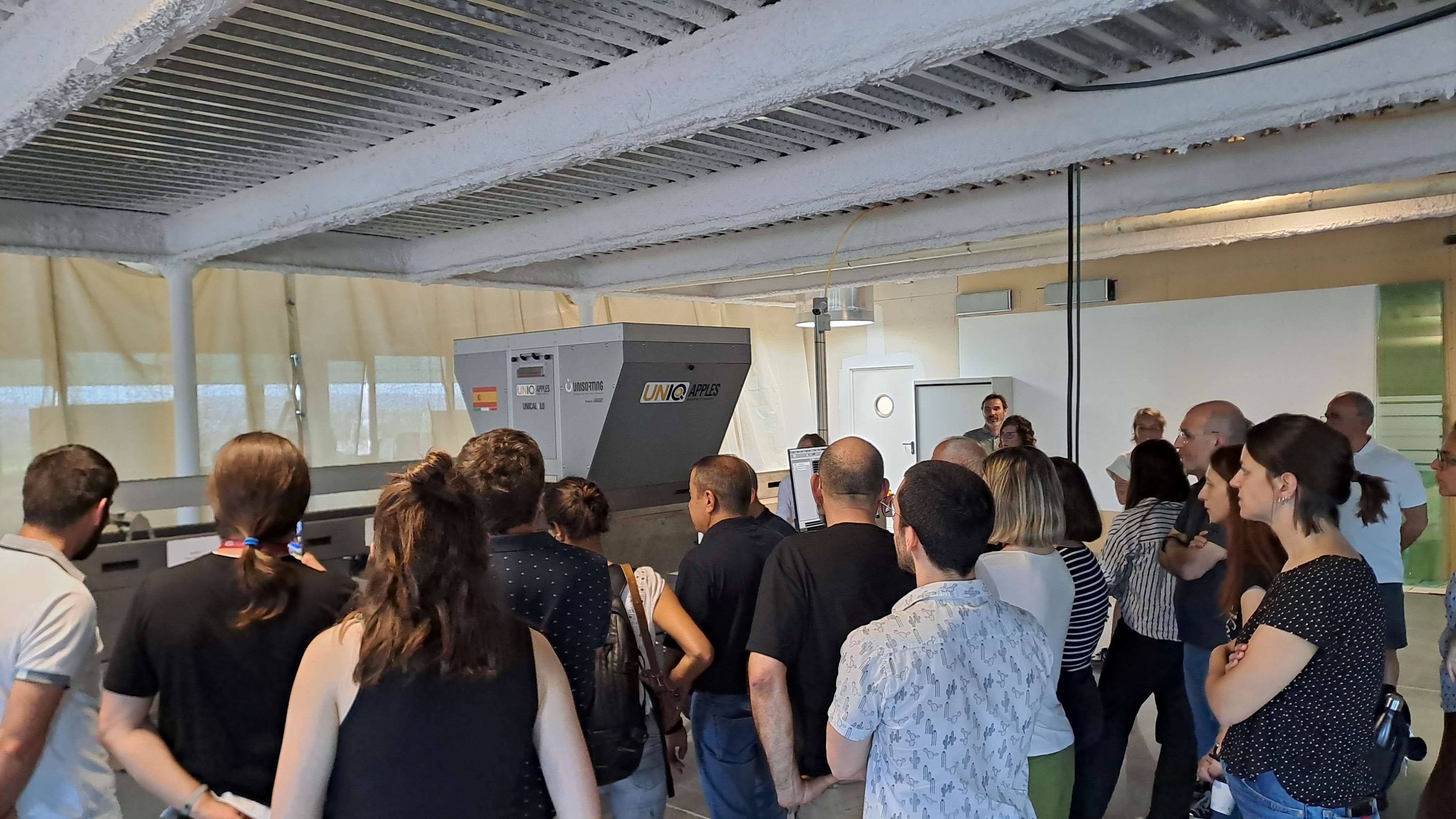
UNIQ Apples demonstrates its operation by sorting apples based on their internal quality
Equipped with high-resolution cameras, it can classify different apple varieties based on their external quality, shape defects, size, and color. The Apple Vision technology allows for the selection of characteristics for any type of apple at a speed of 10 fruits per second per line. Each apple variety has its own software to maximize reliability, performance, and cost-effectiveness.
UNIQ Apples represents a more recent development in apple sorting technology, focusing on assessing internal quality and separating apples with internal defects.
Unitec's history dates back to 1924 with the introduction of the first mechanical sorters. Over the past century, Unitec has pioneered cutting-edge technologies such as electronic grading for virtually all commercially important crops, the UNIQ line for internal quality detection across major species, and specialized solutions not only for apples but also for cherries, blueberries, plums, peaches, kiwi, melons, citrus fruits, nuts, and more. The company is present in key horticultural regions worldwide.
Portable and Non-destructive Quality Sensors
Felix Instruments specializes in non-destructive, portable assessment of fruit and vegetable ripeness. Their sister company, CID Bio-Sciences, focuses on non-destructive instruments for assessing plant parameters such as canopy, roots, photosynthesis, leaf area, and stress.
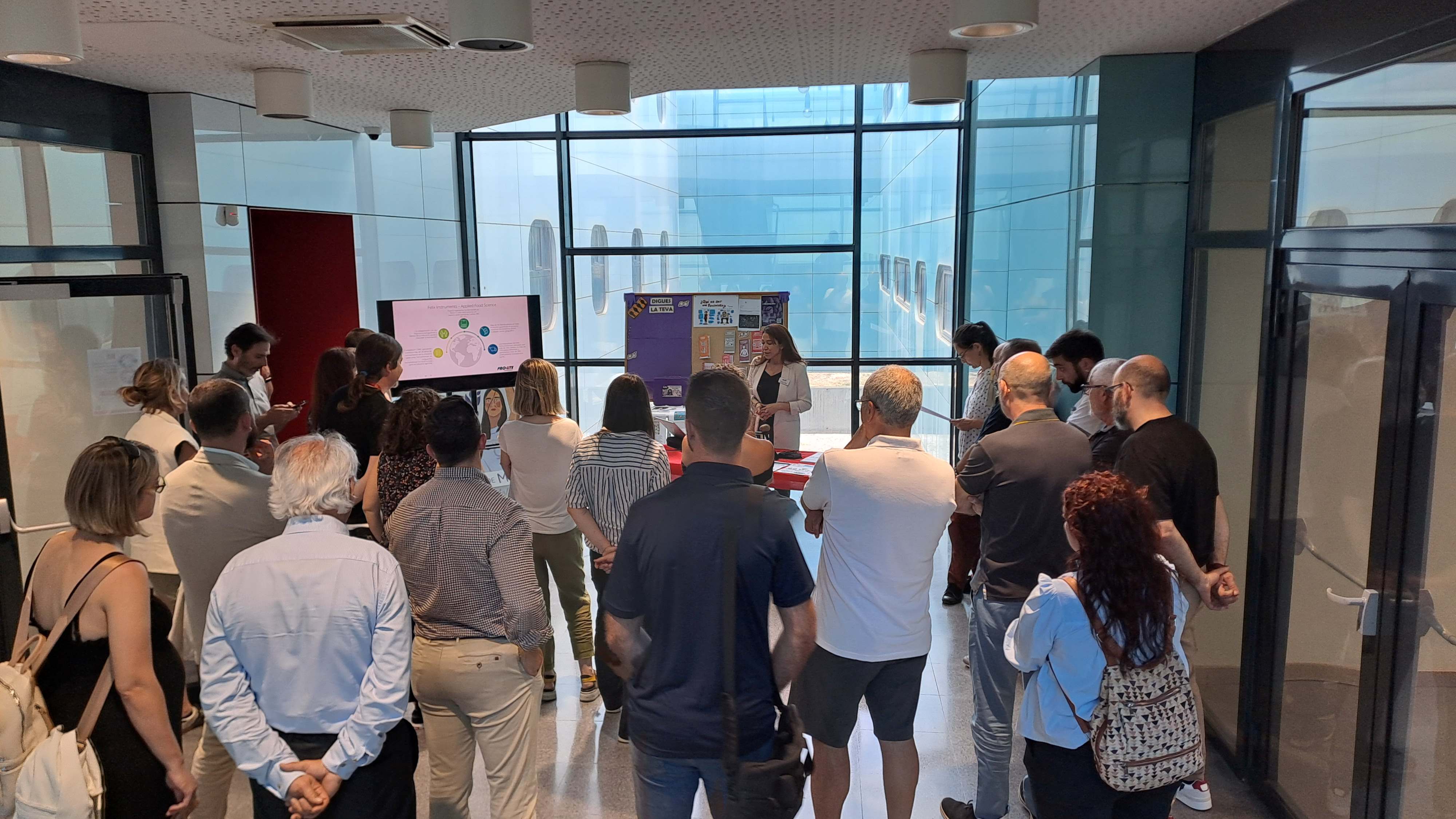
Felix Instruments develops solutions for portable and non-destructive evaluation of internal quality
Their product lines, F-750 and F-751, include maturity meters based on NIR spectroscopy. The company also offers equipment for measuring ethylene and other gases.
Short-wave NIR spectroscopy combined with robust chemometric calibrations allows users to obtain quick, non-destructive measurements of internal quality indicators in fruits.
The F-751 line features specific devices for avocado, kiwi, mango, and melon. The F-750 equipment measures Brix degrees and dry matter content in various fruits and vegetables.
These are precise instruments based on artificial neural network chemometrics and robust data calibration. They are versatile, portable, and ready for use in fields, warehouses, ripening chambers, or any point in the supply chain. They can gather extensive data to inform decisions accurately during critical moments.
Fruitmaps is a free interactive harvest mapping application included in the F-751 line. Besides sample localization, it allows for creating customized charts, wireless data uploading, and remote harvest monitoring.
The company operates through over 90 distributors worldwide and serves clients in more than 100 countries.



